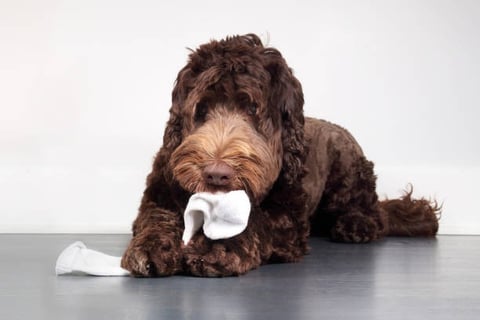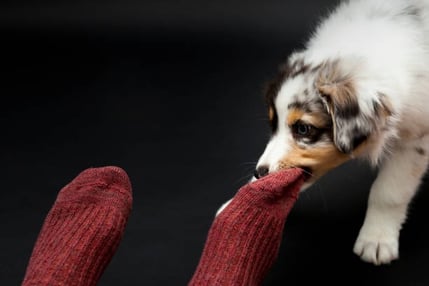My Dog Ate a Sock" – What Should I Do?
Discover expert advice on what to do if your dog swallowed a sock, including signs of ingestion, potential health risks, and prevention tips. Learn why dogs eat socks, how to identify a blockage, and when to seek urgent veterinary care. Keep your furry friend safe with actionable insights for pet owners.
PET CARE AND HEALTH
What to Do If Your Dog Swallowed a Sock? Expert Advice and Prevention Tips
Dogs, being naturally curious and playful, often get into things they shouldn’t. If you’ve ever found yourself saying, “My dog swallowed a sock” or “My puppy ate a sock,” you’re not alone. This is a surprisingly common scenario among pet owners. Socks are soft, easy to chew, and carry the comforting scent of their owner, making them an irresistible object for many dogs.
When a dog swallows a sock, it can lead to various health concerns. The sock may pass naturally through the digestive system, but in many cases, it can cause an obstruction, requiring medical intervention. Understanding what to do in this situation and how to prevent it from happening again is crucial for every dog owner.


Why Did My Dog Eat a Sock?
Dogs explore the world with their mouths, and certain objects—like socks—are particularly appealing to them. There are several reasons why a dog might ingest a sock:
Texture: The soft, fabric-like feel of a sock may be satisfying to chew on, much like a plush toy.
Scent: Dogs have a powerful sense of smell, and since socks often carry their owner’s scent, they can be especially appealing.
Playfulness: Puppies and younger dogs, in particular, may grab socks during play and accidentally swallow them.
Teething: Puppies experiencing discomfort from teething may find socks soothing to chew on.
Boredom or Anxiety: Some dogs engage in destructive chewing when they lack mental stimulation or experience stress.
Pica: This condition causes dogs to crave and eat non-food objects, including socks, and may be linked to underlying health issues or dietary deficiencies.
Regardless of the reason, ingesting a sock poses serious health risks to your dog.
What Happens If My Dog Swallows a Sock?
The outcome of a dog swallowing a sock depends on various factors, including the size of the dog, the size of the sock, and how their digestive system responds. Here are the possible scenarios:
Natural Expulsion: If the sock is small and the dog is large, it may pass naturally through the digestive tract within 48–72 hours. However, this is not a guarantee.
Induced Vomiting: If ingestion happened within the last four hours, a veterinarian might induce vomiting to retrieve the sock safely.
Gastrointestinal Blockage: If the sock becomes lodged in the stomach or intestines, it can cause a dangerous obstruction. This often requires medical imaging (X-rays or ultrasounds) and potentially surgical removal.
Tissue Damage or Necrosis: In severe cases, an intestinal blockage may cut off blood flow, leading to tissue death (necrosis) and life-threatening infections such as peritonitis. aquí...


Signs Your Dog Swallowed a Sock
If you didn’t witness your dog swallowing a sock but suspect they might have, look for these warning signs:
Vomiting or retching
Abdominal pain or discomfort
Loss of appetite
Lethargy and weakness
Diarrhea or constipation
Straining to defecate or absence of stool
Excessive drooling
Symptoms may not appear immediately and can take up to 24 hours to develop. If you notice any of these signs, seek veterinary assistance immediately. tu texto aquí...
What Should I Do If My Dog Ate a Sock?
If you suspect or know that your dog has swallowed a sock, follow these steps:
1. Contact Your Veterinarian Immediately
If ingestion occurred within the last four hours, your vet may induce vomiting to remove the sock.
If more than four hours have passed, inducing vomiting may no longer be an option, and the sock may have moved into the intestines.
2. Monitor Your Dog Closely
Watch for signs of distress, including vomiting, lethargy, or difficulty defecating.
Check their stool over the next few days to see if the sock passes naturally.
3. Do NOT Attempt Home Remedies
Avoid giving fiber-rich foods or substances like hydrogen peroxide without veterinary approval.
Forcing a foreign object through the digestive system may cause further damage.
4. Be Prepared for Surgery if Necessary
If an obstruction occurs, surgical removal is often required.
In some cases, endoscopic retrieval may be possible without full surgery.
If tissue damage has occurred, sections of the intestine may need to be removed.
How Long Does It Take for a Dog to Pass a Sock?
If a sock does pass naturally, it usually takes between 24–72 hours. However, there have been cases where it took up to five days.
It is dangerous to wait too long to see if your dog will pass the sock on their own, as obstructions can worsen over time. Seeking veterinary guidance is always the safest course of action.
How to Prevent Your Dog from Eating Socks
Prevention is key when it comes to keeping your dog safe. Here are some strategies to reduce the risk of sock ingestion:
1. Keep Socks Out of Reach
Store socks in closed drawers, laundry hampers with lids, or secure storage areas.
Avoid leaving socks on the floor where dogs can easily grab them.
2. Provide Safe Chewing Alternatives
Offer durable chew toys, dental chews, and puzzle feeders to keep your dog engaged.
Rotate toys regularly to maintain their interest.
3. Increase Mental and Physical Stimulation
Take your dog on daily walks and provide regular playtime.
Engage them with interactive toys or training exercises.
4. Address Anxiety and Stress
If your dog chews on socks due to anxiety, consider calming techniques such as pheromone diffusers, music therapy, or behavior training.
Consult a professional dog trainer or veterinarian if compulsive chewing persists.
5. Monitor High-Risk Breeds
Some breeds, such as Labrador Retrievers, Golden Retrievers, and Beagles, are more prone to chewing and swallowing foreign objects. Supervise them closely around socks and small objects.
Conclusion
If your dog swallows a sock, acting quickly is crucial to ensure their safety. While some dogs may pass the sock naturally, the risk of obstruction and serious health complications is high. Consulting a veterinarian is always the best course of action.
Prevention is the best way to protect your dog. By keeping socks out of reach, providing plenty of enrichment activities, and addressing any underlying behavioral issues, you can help keep your dog safe and healthy.
Remember: When in doubt, seek veterinary care—your furry friend’s health and well-being depend on it!


